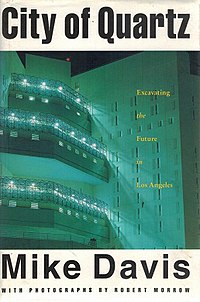From cool blue pools in LA to Yorkshire woodland to desert highways, a major Tate retrospective to mark David Hockney’s 80th birthday celebrates his vibrant vision
Report Finds a Los Angeles in Decline
By ADAM NAGOURNEY
A commission presented a scathing verdict on the civic health of the
city, saying it was falling behind other major cities across the globe.
Hardship Makes a New Home in the Suburbs
By JENNIFER MEDINA
The suburbs east of Los Angeles were once a magnet for restless
newcomers with big aspirations, but jobs never really followed. Today,
poverty is growing faster in suburban areas than in cities or rural
areas.
QUOTATION OF THE DAY
"It's a shame and embarrassing that in a city of 4 million people we are down to one woman."
NURY MARTINEZ, the only woman in elected office in the city of Los Angeles.
Mike Davis《水晶之城:窺探洛杉磯的未來》City of
Crystal: Excavating the Future of Los Angels,1990.林鶴譯,上海人民,2010
Google Books事2006年新版City of Quartz:
Excavating the Future in Los Angeles
(New Edition)
The Exiles 一節實在很精彩的批評那些歐陸學者的窄試
Los Angeles, for all its fleshpots and enchantments, was experienced
as a cultural antithesis to nostalgic memories of Pre-facist Berlin or
Vienna.
迈克•戴维斯(Mike Davis),1946年生,美国社会评论家、城市理论家、历史学家和政治活动家,加州大学河滨分校创意写作系教授。
译者 林鹤,1967年生,1985年就读清华大学建筑系,1993年获建筑历史与理论硕士学位并留校任教,2002年因病去职,著有《西方20世纪别墅二十讲》(三联书店2007年版),并有译作多部。
译者 林鹤,1967年生,1985年就读清华大学建筑系,1993年获建筑历史与理论硕士学位并留校任教,2002年因病去职,著有《西方20世纪别墅二十讲》(三联书店2007年版),并有译作多部。
目录 · · · · · ·
致谢前言 根据昔日的前景所做的展望 The View from Future Past
第一章 是阳光璀璨还是黑色笼罩?Sunshine or Noir?
第二章 权势脉络 Power Lines
第三章 本乡原产的革命Homegrown Revolution
第四章 洛杉矶要塞Fortress L.A.
第五章 “锤子”与“岩石” The Hammer and the Rock
第六章 全新的告解 New Confessions
第七章 堆放梦想碎片的垃圾场 Junkyard of Dreams
附录 报刊杂志译名对照
索引
City of Quartz: Excavating the Future in Los Angeles (New Edition) - Page 48 - Google Books Result
books.google.com.tw/books?isbn=1844675688
Mike Davis - 2006 - Political Science
70 In Los Angeles where Adorno and Horkheimer accumulated their 'data', the ... to become its own myth: Los Angeles as the crystal ball of capitalism's future.City of Quartz
From Wikipedia, the free encyclopedia
| City of Quartz: Excavating the Future in Los Angeles |
|
|---|---|
 |
|
| Country | United States |
| Language | English |
| Subject(s) | History |
| Genre(s) | Non-fiction |
| Publication date | 1990 |
Davis then explores intellectuals' competing ideas of Los Angeles, from the "sunshine" promoted by real estate boosters early in the 20th century, to the "debunkers," the muckraking journalists of the early century, to the "noir" writers of the 1930s and the exiles fleeing from fascism in Europe, and finally the "sorcerers," the scientists at Caltech.
The rest of the book explores how different groups wielded power in different ways: the downtown Protestant elite, led by the Chandler family of the Los Angeles Times, and the new elite of the Jewish westside; the surprisingly powerful homeowner groups, the Los Angeles Police Department, and the Catholic Church. The book concludes at what Davis calls the "junkyard of dreams," the former steel town of Fontana, east of LA, a victim of de-industrialization and decay.
The 2nd edition of the book, published in 2006, contains a new preface detailing changes in Los Angeles since the work was written in the late 1980s.
Critical reception
The Los Angeles Times architecture critic, Christopher Hawthorne, criticized "City of Quartz" for its "dark generalization and knee-jerk far-leftism," but concluded that the book "is without question the most significant book on Los Angeles urbanism to appear since Reyner Banham's "Los Angeles: The Architecture of Four Ecologies" was published in 1971." He ranked it "one of the three most important treatments of that subject ever written, joining "Four Ecologies" and Carey McWilliams' 1946 book "Southern California: An Island on the Land."[1]In the Boston Review, Mark Haefele called the book "a black hole of Southland noir," but also wrote, "What's brilliant about Davis's book is his perception of Los Angeles as incarceration, its new prisons a major industry. . . . He's right that a broad landscape of the city is turning itself into Postmodern Piranesi. And to young black males in particular, the city has become a prisoner factory."[2]
The San Francisco Examiner concluded that “Few books shed as much light on their subjects as this opinionated and original excavation of Los Angeles from the mythical debris of its past and future”, and Peter Ackroyd, writing in The Times of London, called the book “A history as fascinating as it is instructive.”[3]
Reviews
- Blanchard, Marc. Cultural Anthropology, Vol. 7, No. 4 (November, 1992).
- Decker, Jeffrey Louis. American Quarterly, Vol. 44, No. 1 (March, 1992)
- Erie. Steven P. Political Science Quarterly, Vol. 107., No. 1 (Spring, 1992).
- Ford, Richard T. Transition, No. 57 (1992).
- Horton, John. Contemporary Sociology, Vol. 20, No. 6 (November, 1991).
- Kirkham, Pat. Journal of Design History, Vol. 5., No. 2 (1992).
- Knox, Paul. Annals of the Association of American Geographers, Vol. 83, No. 1 (March 1993).
- Williams, Rosalind. Journal of American History, Vol. 79, No. 4 (March, 1993).
References
- ^ Christopher Hawthorne, "Reading L.A.," http://latimesblogs.latimes.com/culturemonster/2011/06/where-to-start-when-it-comes-to-city-of-quartz-mike-daviss-1990-polemic-against-the-rampant-privatization-and-gated-communi.html
- ^ Mark Haefele, "Explaining Los Angeles," http://bostonreview.net/BR19.3/haefele.html
- ^ reviews of City of Quartz, http://www.versobooks.com/books/125-city-of-quartz





沒有留言:
張貼留言
注意:只有此網誌的成員可以留言。